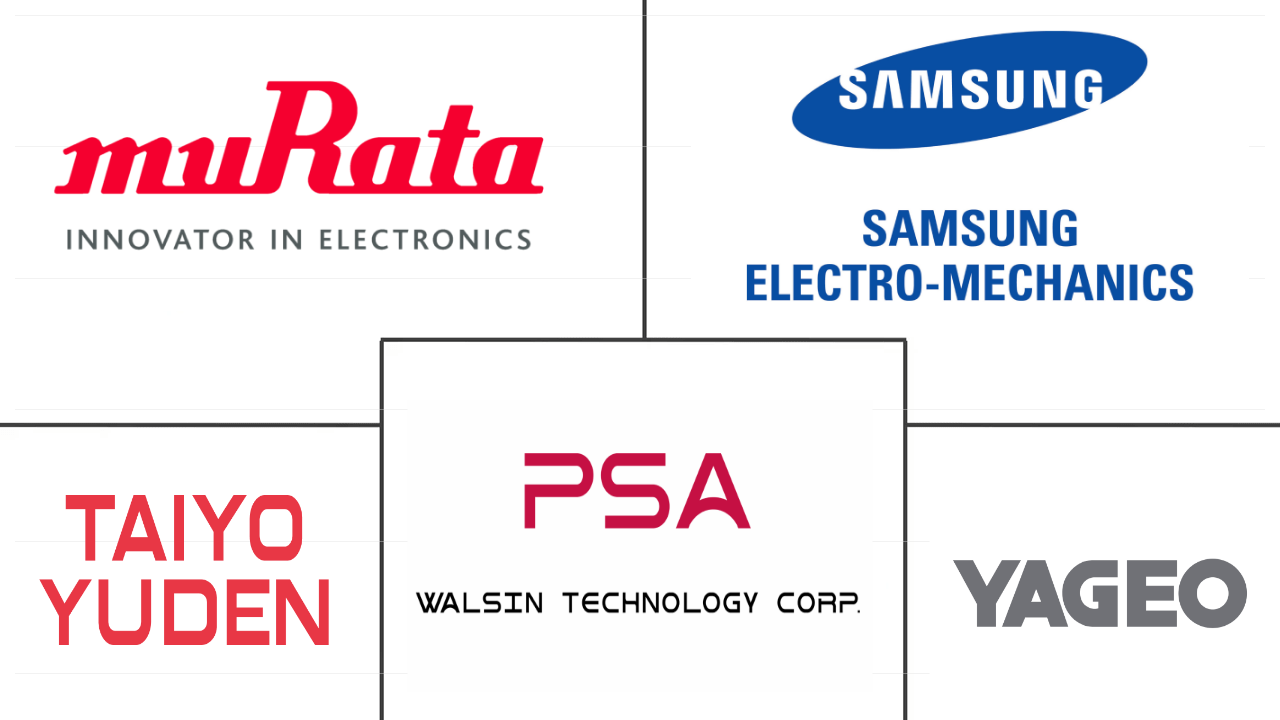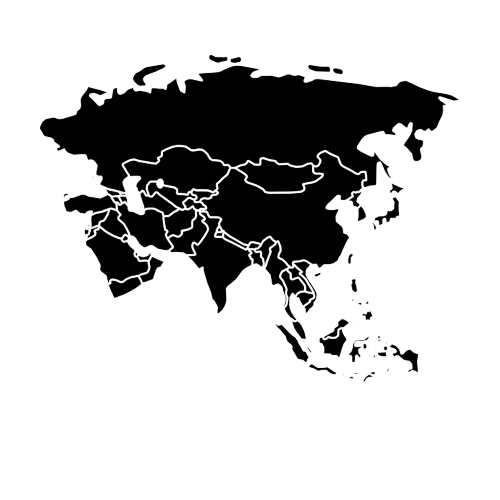Market Size of aerospace and defence mlcc Industry
| Icons | Lable | Value |
|---|---|---|
|
|
Study Period | 2017 - 2029 |
|
|
Market Size (2024) | USD 1.09 Billion |
|
|
Market Size (2029) | USD 2.86 Billion |
|
|
Largest Share by Case Size | 0 201 |
|
|
CAGR (2024 - 2029) | 21.39 % |
|
|
Largest Share by Region | Asia-Pacific |
|
|
Market Concentration | Medium |
Major Players |
||

|
||
|
*Disclaimer: Major Players sorted in no particular order |
Aerospace and Defence MLCC Market Analysis
The Aerospace and Defence MLCC Market size is estimated at 1.09 billion USD in 2024, and is expected to reach 2.86 billion USD by 2029, growing at a CAGR of 21.39% during the forecast period (2024-2029).
1.09 Billion
Market Size in 2024 (USD)
2.86 Billion
Market Size in 2029 (USD)
13.56 %
CAGR (2017-2023)
21.39 %
CAGR (2024-2029)
Largest Segment by Vehicle Type
87.03 %
value share, Manned Aerial Vehicle, 2023
The newer generation aircraft offer better fuel efficiency and safety for commercial and general aviation customers and better situational awareness and tactical advantage for military customers.
Largest Segment by Case Size
31.57 %
value share, 0 201, 2023
The aerospace and defense industries are increasingly using 0201 MLCCs for a variety of applications, particularly those related to military aircraft and electronic warfare defense systems, such as UAVs.
Largest Segment by Capacitance
47.57 %
value share, Less than 10 μF, 2023

The growing adoption of smart technology for surveillance, analysis, and imaging on several fronts is expected to boost the growth of unmanned aerial vehicles that use MLCCs with less than 10µF capacitance.
Fastest Segment by Dielectric Type
22.31 %
Projected CAGR, Class 1, 2024-2029

The Class 1 dielectric-type MLCCs like C0G, X8G, and U2J are growing due to their reliability and accuracy, making them the preferred ceramic capacitors for various applications that require stable performance in demanding environments.
Largest Segment by Region
44.97 %
value share, Asia-Pacific, 2023

The rapid economic development in the region has prompted countries such as China, Japan, India, and South Korea to invest heavily in the development of the aerospace and defense sectors. These strategic initiatives are designed to protect a nation's security and strengthen its expanding economy by promoting the development of aircraft and defense capabilities.
Optimized avionic MLCC selection enhances aerospace and defense systems
- The aerospace and defense industries are witnessing a rapid transformation with the increasing adoption of advanced avionics technologies, including AI, IoT, and 5G communications. These trends drive the need for MLCCs with higher capacitance, lower ESR, and improved reliability to support cutting-edge electronic systems in aircraft. Case sizes 0 201 and 0 402 MLCCs are popular for compact and lightweight electronic circuits in avionics. Their small form factor and high capacitance make them ideal for miniaturized devices, such as flight control systems, navigation systems, and communication equipment in UAVs and other small aircraft. The trend toward miniaturization and weight reduction in avionics drives the demand for case sizes 0 201 and 0 402 MLCCs.
- Case sizes 0 603 and 1 005 MLCCs balance compactness and capacitance, making them versatile components in various avionic applications. They are commonly used in cockpit displays, sensor systems, and power distribution networks in manned and unmanned aerial vehicles. The increasing adoption of advanced avionics systems in modern aircraft enhances the demand for case sizes 0 603 and 1 005 MLCCs.
- Case size 1 210 MLCCs offer higher capacitance values and are well-suited for power management, energy storage, and filtering applications in avionics. These larger-sized MLCCs are commonly utilized in critical avionic systems like radar systems, satellite communications, and advanced avionics control units. The evolving need for more powerful and sophisticated avionic technologies contributes to the demand for case sizes 1 210 and other MLCCs. The demand for UAVs and MAVs is growing, and MLCCs play a vital role in ensuring stable and efficient electronic components for successful operation.
The global aerospace and defense MLCC market thrives amid rising defense expenditures and geopolitical dynamics
- The aerospace and defense MLCC market experiences robust growth globally. In Asia-Pacific, led by China and India, the segment generated USD 362.03 million in 2022, with a projected surge to USD 1.06 billion by 2028, showcasing a robust CAGR of 20.37% from 2023 to 2028. India, with a substantial INR 5.94 lakh crore budget for FY 2023-24, emphasizes MLCCs' pivotal role in advancing defense capabilities, particularly in unmanned aerial vehicles (UAVs).
- Europe witnessed a noteworthy uptick in defense spending, reaching USD 116.05 million by 2021, reflecting a 3% increase from 2020 to 2021. Amid the Russia-Ukraine conflict in 2022, Europe reinforced its defense capabilities, resulting in a 14% surge in defense expenditures to USD 345 billion. MLCCs play a vital role in this context, ensuring signal integrity in military aircraft and defense systems and contributing to the sector's envisioned revenue target of USD 331.16 million by 2028.
- North America, as the dominant force in global military expenditures, invests significantly in defense, with a cumulative expenditure of USD 912 billion in 2022. The aerospace and defense sector, particularly in the United States, contributes USD 391 billion to the economy, with MLCCs playing a pivotal role in ensuring the reliable operation of military aircraft and electronic warfare defense systems.
- The Rest of the World, encompassing the Middle East, Africa, and South America, grapples with geopolitical challenges, terrorism threats, and increased defense spending. Across these regions, the aerospace and defense MLCC market reflects a convergence of economic dynamics, geopolitical influences, and defense priorities, with MLCCs emerging as critical components ensuring the reliability and efficiency of aerospace and defense systems.
Aerospace and Defence MLCC Industry Segmentation
Manned Aerial Vehicle, Unmanned Aerial Vehicle are covered as segments by Vehicle Type. 0 201, 0 402, 0 603, 1 005, 1 210, Others are covered as segments by Case Size. 600V to 1100V, Less than 600V, More than 1100V are covered as segments by Voltage. 10 μF to 100 μF, Less than 10 μF, More than 100 μF are covered as segments by Capacitance. Class 1, Class 2 are covered as segments by Dielectric Type. Asia-Pacific, Europe, North America are covered as segments by Region.
- The aerospace and defense industries are witnessing a rapid transformation with the increasing adoption of advanced avionics technologies, including AI, IoT, and 5G communications. These trends drive the need for MLCCs with higher capacitance, lower ESR, and improved reliability to support cutting-edge electronic systems in aircraft. Case sizes 0 201 and 0 402 MLCCs are popular for compact and lightweight electronic circuits in avionics. Their small form factor and high capacitance make them ideal for miniaturized devices, such as flight control systems, navigation systems, and communication equipment in UAVs and other small aircraft. The trend toward miniaturization and weight reduction in avionics drives the demand for case sizes 0 201 and 0 402 MLCCs.
- Case sizes 0 603 and 1 005 MLCCs balance compactness and capacitance, making them versatile components in various avionic applications. They are commonly used in cockpit displays, sensor systems, and power distribution networks in manned and unmanned aerial vehicles. The increasing adoption of advanced avionics systems in modern aircraft enhances the demand for case sizes 0 603 and 1 005 MLCCs.
- Case size 1 210 MLCCs offer higher capacitance values and are well-suited for power management, energy storage, and filtering applications in avionics. These larger-sized MLCCs are commonly utilized in critical avionic systems like radar systems, satellite communications, and advanced avionics control units. The evolving need for more powerful and sophisticated avionic technologies contributes to the demand for case sizes 1 210 and other MLCCs. The demand for UAVs and MAVs is growing, and MLCCs play a vital role in ensuring stable and efficient electronic components for successful operation.
| Vehicle Type | |
| Manned Aerial Vehicle | |
| Unmanned Aerial Vehicle |
| Case Size | |
| 0 201 | |
| 0 402 | |
| 0 603 | |
| 1 005 | |
| 1 210 | |
| Others |
| Voltage | |
| 600V to 1100V | |
| Less than 600V | |
| More than 1100V |
| Capacitance | |
| 10 μF to 100 μF | |
| Less than 10 μF | |
| More than 100 μF |
| Dielectric Type | |
| Class 1 | |
| Class 2 |
| Region | |
| Asia-Pacific | |
| Europe | |
| North America | |
| Rest of the World |
Aerospace and Defence MLCC Market Size Summary
The Aerospace and Defence MLCC market is experiencing significant growth, driven by the increasing integration of advanced avionics technologies such as AI, IoT, and 5G communications. This evolution necessitates MLCCs with enhanced specifications, including higher capacitance and improved reliability, to support sophisticated electronic systems in aircraft. The demand for compact and lightweight MLCCs, particularly case sizes 0 201 and 0 402, is rising due to the trend towards miniaturization in avionics. These components are essential for applications in flight control, navigation, and communication systems in UAVs and other small aircraft. Additionally, larger case sizes like 1 210 are crucial for power management and energy storage in critical avionic systems, reflecting the industry's need for more powerful technologies.
Globally, the aerospace and defence MLCC market is robust, with regions like Asia-Pacific, Europe, and North America leading in demand due to increased defense spending and the growing need for reliable electronic components in military and avionic applications. The market's expansion is further supported by advancements in MLCC technology, which offer high reliability and fast response times, facilitating the development of real-time UAV applications. Despite challenges posed by the COVID-19 pandemic, which temporarily shifted focus to medical technology, the market is poised for recovery as defense spending stabilizes. The market is moderately consolidated, with key players like Murata Manufacturing, Samsung Electro-Mechanics, and Taiyo Yuden driving innovation and meeting the evolving demands of the aerospace and defence sectors.
Aerospace and Defence MLCC Market Size - Table of Contents
-
1. MARKET SEGMENTATION (includes market size in Value in USD and Volume, Forecasts up to 2029 and analysis of growth prospects)
-
1.1 Vehicle Type
-
1.1.1 Manned Aerial Vehicle
-
1.1.2 Unmanned Aerial Vehicle
-
-
1.2 Case Size
-
1.2.1 0 201
-
1.2.2 0 402
-
1.2.3 0 603
-
1.2.4 1 005
-
1.2.5 1 210
-
1.2.6 Others
-
-
1.3 Voltage
-
1.3.1 600V to 1100V
-
1.3.2 Less than 600V
-
1.3.3 More than 1100V
-
-
1.4 Capacitance
-
1.4.1 10 μF to 100 μF
-
1.4.2 Less than 10 μF
-
1.4.3 More than 100 μF
-
-
1.5 Dielectric Type
-
1.5.1 Class 1
-
1.5.2 Class 2
-
-
1.6 Region
-
1.6.1 Asia-Pacific
-
1.6.2 Europe
-
1.6.3 North America
-
1.6.4 Rest of the World
-
-
Aerospace and Defence MLCC Market Size FAQs
How big is the Global Aerospace and Defence MLCC Market?
The Global Aerospace and Defence MLCC Market size is expected to reach USD 1.09 billion in 2024 and grow at a CAGR of 21.39% to reach USD 2.86 billion by 2029.
What is the current Global Aerospace and Defence MLCC Market size?
In 2024, the Global Aerospace and Defence MLCC Market size is expected to reach USD 1.09 billion.

